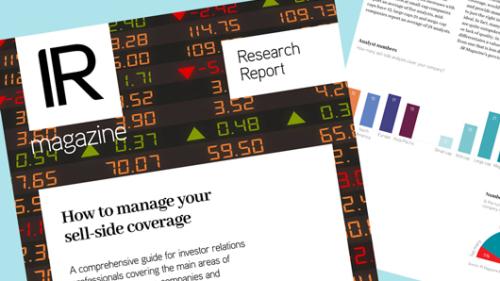The information in consensus estimates is useful for more than just earnings announcements, says Alex Money
Q: How can I get real strategic IR value from analyst consensus estimates?
A: There is embedded value in consensus estimates but, at many companies, the data are not merely unrecognized but also often discarded, despite the work required to create them.
Companies typically collate consensus forecasts for a range of reasons: market expectations give management and stakeholders a benchmark for assessing operational performance and outlook; a transparent market view of forecasts arguably improves share price formation; and forecasts can help IROs fulfill regulatory obligations in terms of disclosure of price-sensitive information.
Generally, forecasts are collected quarterly, usually in closed periods, and often just ahead of the company providing a market update. To ensure the validity of the data, IR departments usually check that the underlying analysts’ estimates are comparable, complete and current. This is time-consuming and resource-intensive, particularly where it involves taking apart analysts’ models to ensure apples are being compared with apples. Once the process is complete, various outputs are circulated internally and externally, and usually some reference is made to this information at the time of results announcements.
But where does the information go from there? At best, historic forecasts are systematically filedfor ‘archival purposes’. At worst, these forecasts end their life as a dormant email attachment, never to be opened again.
Yet unlocking the embedded value in consensus estimates can deliver tangible and measurable benefits. Here are three examples.
Evaluating the sell side. Market forecasts include a range, and analysts’ strengths and weaknesses vary. Some are better at certain line items; others incorporate macro data better. An objective and thorough evaluation process will allow you to be more efficient in terms of the time and resources you devote to different analysts. You can also use this information as screening criteria for such matters as allocating sell-side roadshows.
Evaluating the market environment. It can be difficult to assess how much forecasts are changing because of sector or market sentiment rather than in response to company-specific factors, especially in periods of volatility. Analyzing historic forecasts, with an overlay of sector or market prices, often indicates which factors are driving changes in company estimates.
Evaluating your process. Scrutinizing consensus forecasts can be a powerful tool for answering questions like: on which line items is the message consistently getting across? Where are the biggest gaps in understanding? Where could you do more to improve market understanding?
‘You cannot manage what you cannot measure’ applies to IR as much as anything else so tools that help with evaluation offer the potential for a step-change in your approach and effectiveness.
Alex Money is a partner at Temple Bar Advisory in London.
This article appeared in the August print edition of IR magazine.










